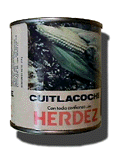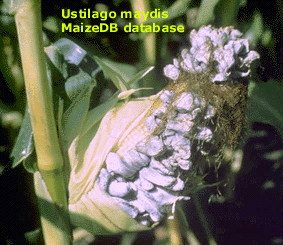Is it true that some people eat corn smut?
 Yes, in the central Mexican highlands corn "smut" is considered a delicacy. In fact, since this part of the world includes several large population centers, including Mexico City (21 million inhabitants), Guadalajara (6 million) and Puebla (3 million), this establishes sufficient demand to support a commercial industry to produce and deliver corn smut as a canned product. This shouldn't really be that surprising. In spite of its name, corn "smut" is simply a mushroom, and many other types of mushrooms are also consumed by people all around the world. Yes, in the central Mexican highlands corn "smut" is considered a delicacy. In fact, since this part of the world includes several large population centers, including Mexico City (21 million inhabitants), Guadalajara (6 million) and Puebla (3 million), this establishes sufficient demand to support a commercial industry to produce and deliver corn smut as a canned product. This shouldn't really be that surprising. In spite of its name, corn "smut" is simply a mushroom, and many other types of mushrooms are also consumed by people all around the world.
 The fungus, Ustilago maydis, is a soil-borne organism that infects the meristems (or growing points) of corn. This means that the base of internodes, the base and midrib of leaves, and young ears are particularly susceptible to infection. Certain fields and cultivars are known to be particularly suitable for corn smut production, and early season drought seems to predispose plants to infection. Sweet corn is also notoriously susceptible to corn smut, and it is only in this vegetable crop with relatively high cash value that the fungus causes significant economic losses in the USA. In Mexico this fungus is known as "cuitlacoche" or "huitlacoche," modifications of the Nahuatl ("Aztec") name, and by contrast it commonly sells for a higher price than uninfected corn grain. When the fungus infects a young ear, it appropriates the plant's energy to produce dark spores that fill the interior of what normally would be kernels. Massive production of such spores forms large "galls" that are grayish in color due to the dark color of the spores which can be seen through the distended and translucent skin of the kernels. Such ears are particularly prized because, as you might expect, the earthy flavor of the fungus combines with a subtle corn flavor. As with other mushrooms, cuitlacoche is most often eaten as an ingredient in a sautee sauce that is used to complement meat dishes or eggs at breakfast. Though it is less common, some people also like to use the mature fungal spores as a condiment to sprinkle their food. The fungus, Ustilago maydis, is a soil-borne organism that infects the meristems (or growing points) of corn. This means that the base of internodes, the base and midrib of leaves, and young ears are particularly susceptible to infection. Certain fields and cultivars are known to be particularly suitable for corn smut production, and early season drought seems to predispose plants to infection. Sweet corn is also notoriously susceptible to corn smut, and it is only in this vegetable crop with relatively high cash value that the fungus causes significant economic losses in the USA. In Mexico this fungus is known as "cuitlacoche" or "huitlacoche," modifications of the Nahuatl ("Aztec") name, and by contrast it commonly sells for a higher price than uninfected corn grain. When the fungus infects a young ear, it appropriates the plant's energy to produce dark spores that fill the interior of what normally would be kernels. Massive production of such spores forms large "galls" that are grayish in color due to the dark color of the spores which can be seen through the distended and translucent skin of the kernels. Such ears are particularly prized because, as you might expect, the earthy flavor of the fungus combines with a subtle corn flavor. As with other mushrooms, cuitlacoche is most often eaten as an ingredient in a sautee sauce that is used to complement meat dishes or eggs at breakfast. Though it is less common, some people also like to use the mature fungal spores as a condiment to sprinkle their food.
Here are a few recipes published in various places on the Web:
Ricardo J. Salvador
|

 Yes, in the central Mexican highlands corn "smut" is considered a delicacy. In fact, since this part of the world includes several large population centers, including Mexico City (21 million inhabitants), Guadalajara (6 million) and Puebla (3 million), this establishes sufficient demand to support a commercial industry to produce and deliver corn smut as a canned product. This shouldn't really be that surprising. In spite of its name, corn "smut" is simply a mushroom, and many other types of mushrooms are also consumed by people all around the world.
Yes, in the central Mexican highlands corn "smut" is considered a delicacy. In fact, since this part of the world includes several large population centers, including Mexico City (21 million inhabitants), Guadalajara (6 million) and Puebla (3 million), this establishes sufficient demand to support a commercial industry to produce and deliver corn smut as a canned product. This shouldn't really be that surprising. In spite of its name, corn "smut" is simply a mushroom, and many other types of mushrooms are also consumed by people all around the world.